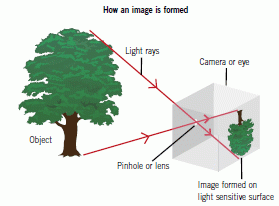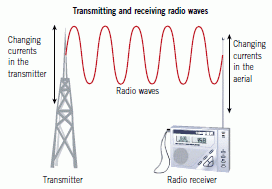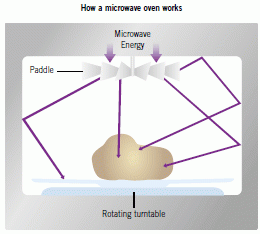Light, Radio Waves and Microwaves
Visible Light
When electromagnetic radiation from the Sun arrives at the top of the atmosphere some of it is reflected, some is transmitted to the Earth’s surface and some is absorbed by the atmosphere.
The electromagnetic radiation that arrives at the Earth’s surface is:
- High energy infrared.
- Visible light.
- Low energy ultraviolet.
Some of the ways visible light is used include:
- By our eyes when images are formed on the retina at the back of the eye.
- Photography when images are formed on the light sensitive film in a camera.
- Digital photography when images are formed on the light sensitive screen and stored electronically.
- Plants use light as an energy source for photosynthesis.

The human eye is similar to a camera. In both, light rays pass through a small hole and produce a small upside down image. A lens can be used to gather and focus more light.
The image is formed on a light sensitive surface:
- On photographic film a chemical reaction occurs which changes the colour of the film.
- On the cells of the retina a chemical reaction causes electric signals to travel along the optic nerve to the brain.
- On the screen inside a digital camera electronic signals are sent to the memory. The amount of information to store the picture is measured in bytes.
This video explains how light travels
Reflection of Light
This video explains how light is reflected
Radio Waves
Radio waves are produced when an alternating current flows in an aerial. They spread out and travel through the atmosphere.
Another aerial is used as a detector. The radio waves produce an alternating current in it, with a frequency that matches that of the waves.

Microwaves
Microwaves are transmitted through glass and plastics. They are absorbed by water, though how well depends on the frequency (energy) of the microwaves.
Microwave ovens use a microwave frequency which is strongly absorbed by water molecules, causing them to vibrate, increasing their kinetic energy. This heats materials containing water, for example food. The microwaves penetrate about 1 cm into the food. Conduction and convection processes spread the heat through the food.
Microwave oven radiation will heat up our body cells and is very dangerous at high intensity because it will burn body tissue. The radiation is kept inside the oven by the reflecting metal case and metal grid in the door.

Radio Waves and Microwaves
Some important properties of radio waves and microwaves are:
- They are reflected by metal surfaces.
- They heat materials if they can make particles in the material vibrate.
- The amount of heating depends on the power of the radiation and the time that the material is exposed to the radiation.
